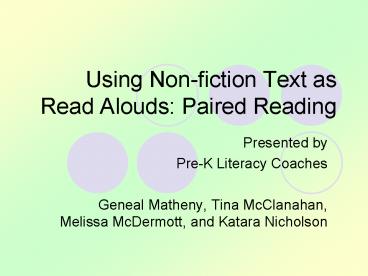Using Nonfiction Text as Read Alouds: Paired Reading - PowerPoint PPT Presentation
1 / 19
Title:
Using Nonfiction Text as Read Alouds: Paired Reading
Description:
Learn strategies for reading aloud non-fiction and fiction ... Pre-K Literacy Coaches. Geneal Matheny, Tina McClanahan, Melissa McDermott, and Katara Nicholson ... – PowerPoint PPT presentation
Number of Views:397
Avg rating:3.0/5.0
Title: Using Nonfiction Text as Read Alouds: Paired Reading
1
Using Non-fiction Text as Read Alouds Paired
Reading
- Presented by
- Pre-K Literacy Coaches
- Geneal Matheny, Tina McClanahan, Melissa
McDermott, and Katara Nicholson
2
K-W-L
3
Presentation Objectives
- Learn the importance of using non-fiction text in
Pre-K classrooms. - Learn strategies for reading aloud non-fiction
and fiction text sets (paired reading). - Discuss ways to use the paired reading strategy
in their classrooms. - Develop ways to use graphic organizers to extend
learning.
4
Importance of Non-fiction Texts in Pre-K
- Children need concrete experiences.
- Children are naturally curious and love learning
new things. - Gain background knowledge about a variety of
topics. - Contributes to vocabulary development.
5
Examples of Non-fiction Texts
- Magazines
- Books
- Posters
- Newspapers
- Teacher made books
6
Using Non-fiction Text as Read Alouds Paired
Reading
- Paired Reading is
- Text sets that include a non-fiction text and a
fiction book on a similar topic to enhance
student learning.
7
Planning and Preparing for Paired Reading
- When
- Pacing guide
- Daily schedule
8
Planning and Preparing for Paired Reading
- Determine the Objective
- Research the Topic
- Select your Text
9
Planning and Preparing for Non-fiction Read Alouds
- Text Selection
- Age appropriate length
- Clear pictures/photographs
- Rich vocabulary
- Relates to theme or students interest
10
Planning and Preparing for Non-fiction Read Alouds
- What strategies do you use to plan your story
time lessons? - ?
11
Planning and Preparing for Non-fiction Read Alouds
- Read the book ahead of time.
- Plan your questions and think alouds.
- Plan your talking points and explanations.
- Plan how you might make connections to the topic
throughout the day.
12
Teaching Children How Non-fiction Works Before
Reading
- Explain to the children
- What you are reading.
- Why you are reading it.
- Lets write!
13
Teaching Children How Non-fiction Works During
Reading
- Use the natural flow of text to explain unique
text features. - Foreshadow any connections to upcoming read-aloud
texts. - At the conclusion of the non-fiction read,
introduce briefly the fiction texts that
correlates.
14
Teaching Children How Non-fiction Works After
Reading
- Use a graphic organizer.
- Place paired texts in the classroom.
Kitten for a Day
15
Using Non-fiction Text as Read Alouds Paired
Reading
- Lets see how its done
swamps
16
You try it
- Planning and preparing
- Determine your objective
- Research your topic
- Select your text
- Read the book
- Plan your questions and think alouds
- Plan your talking points and explanations
- Plan how you might make connections to the topic
throughout the day.
17
KWL
- What did you learn?
18
References
- Shedd, M.K., N.K. Duke. 2008. The Power of
Planning Developing Effective Read-Alouds. Beyond
the Journal Young Children on the Web.
http//www.journal.naeyc.org - Taberski, Sharon. 2001. Fact and fiction read
aloud. http//content.scholastic.com/browse/articl
e.jsp?id3344 - Lane, H. Wright, T. (2007). Maximizing the
effectiveness of reading aloud. The Reading
Teacher, 60, 668-675.
19
Using Non-fiction Text as Read Alouds Paired
Reading
- Presented by
- Pre-K Literacy Coaches
- Geneal Matheny, Tina McClanahan, Melissa
McDermott, and Katara Nicholson































